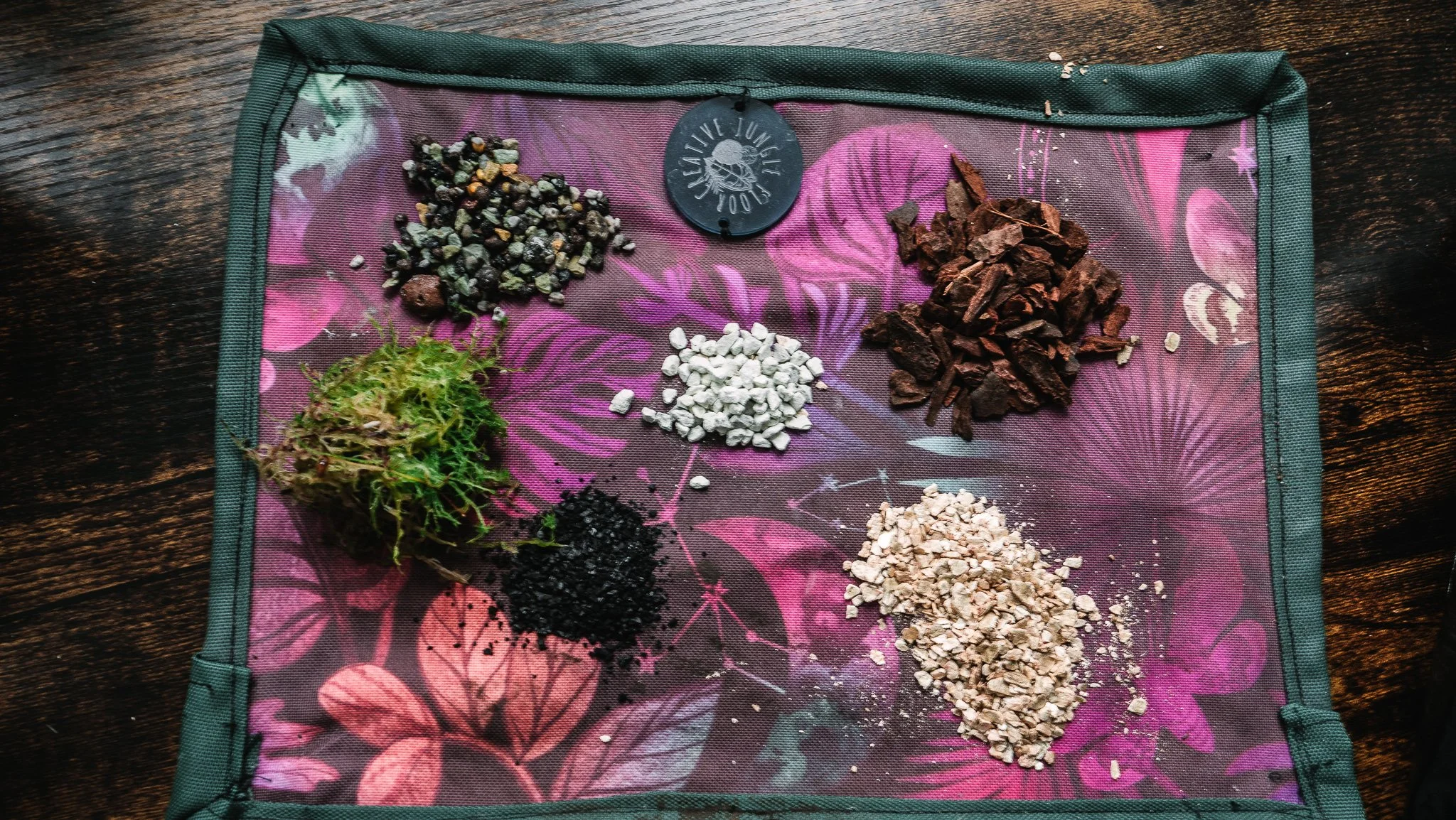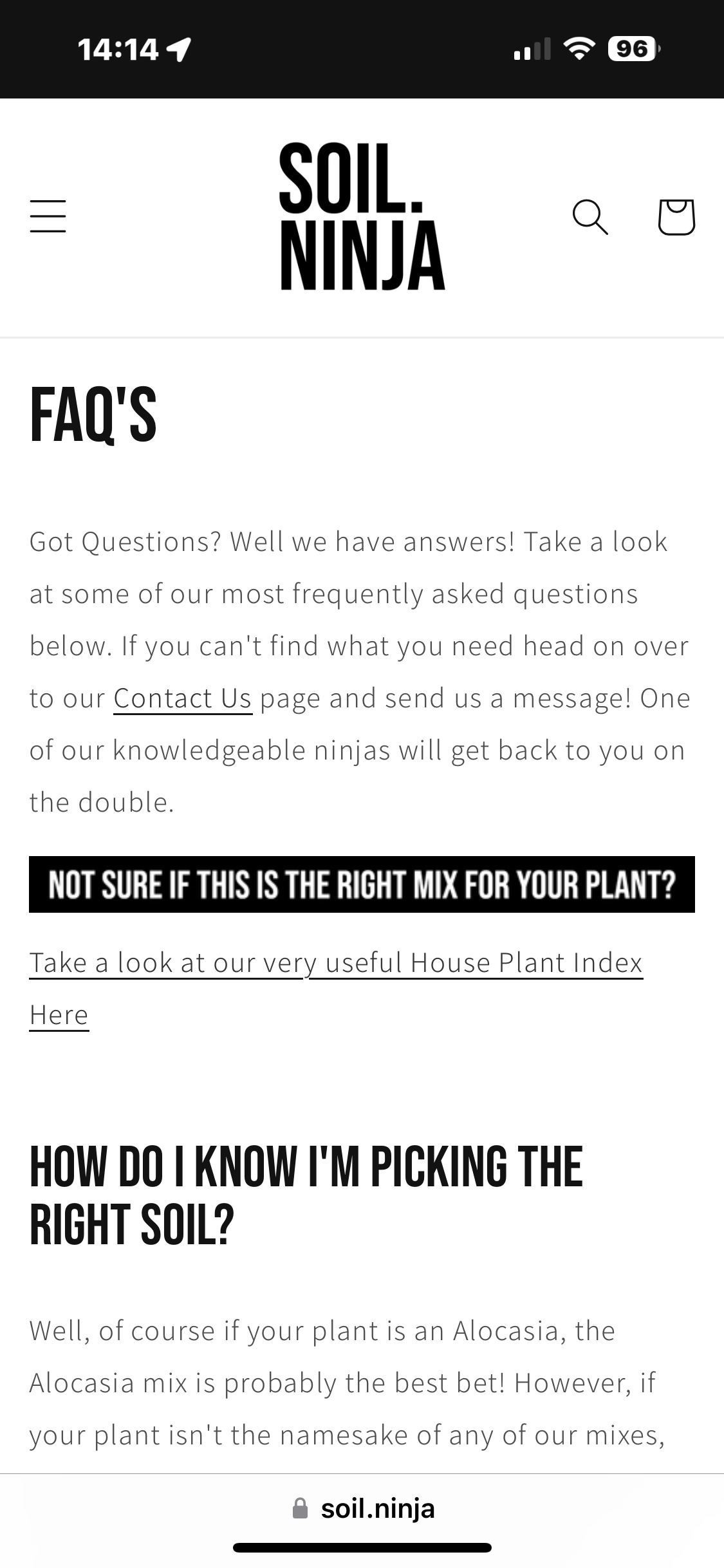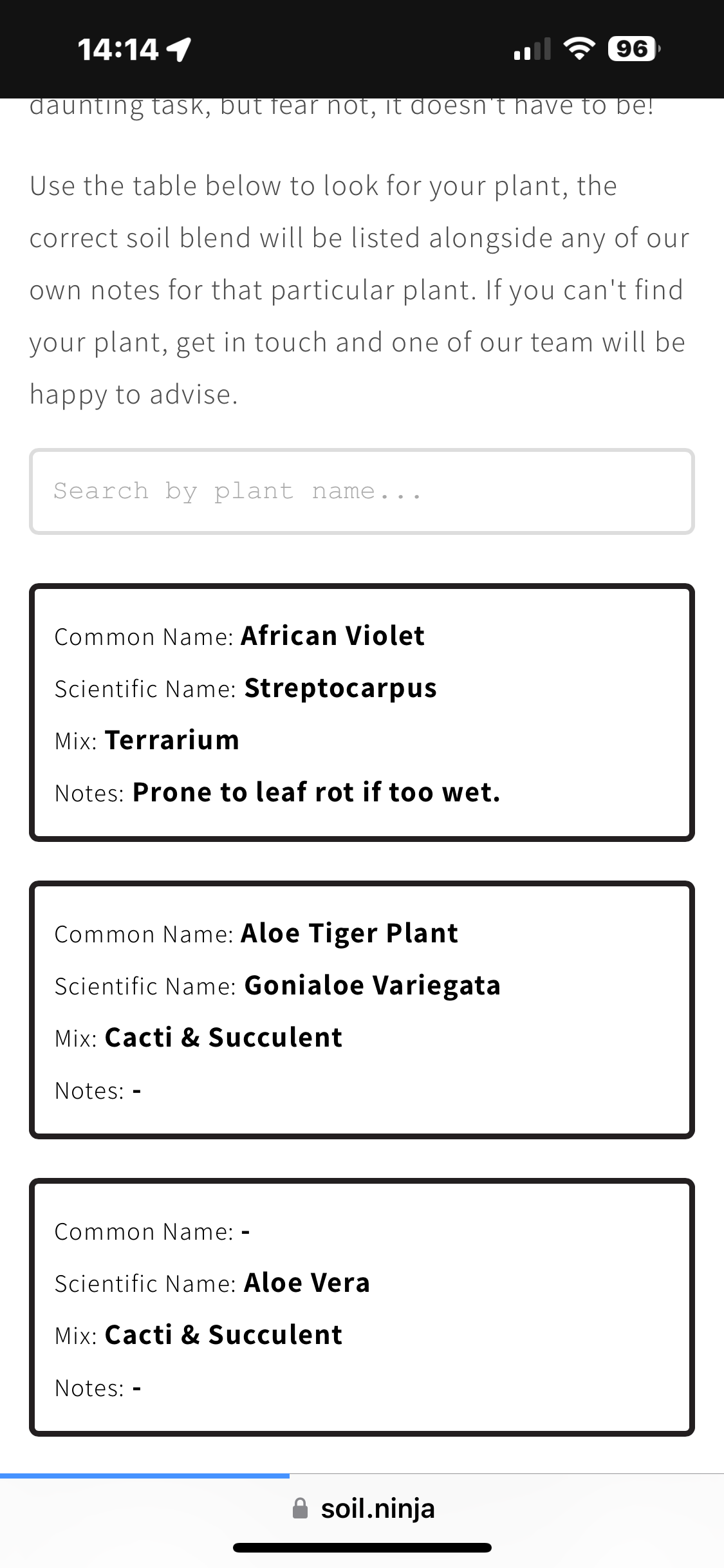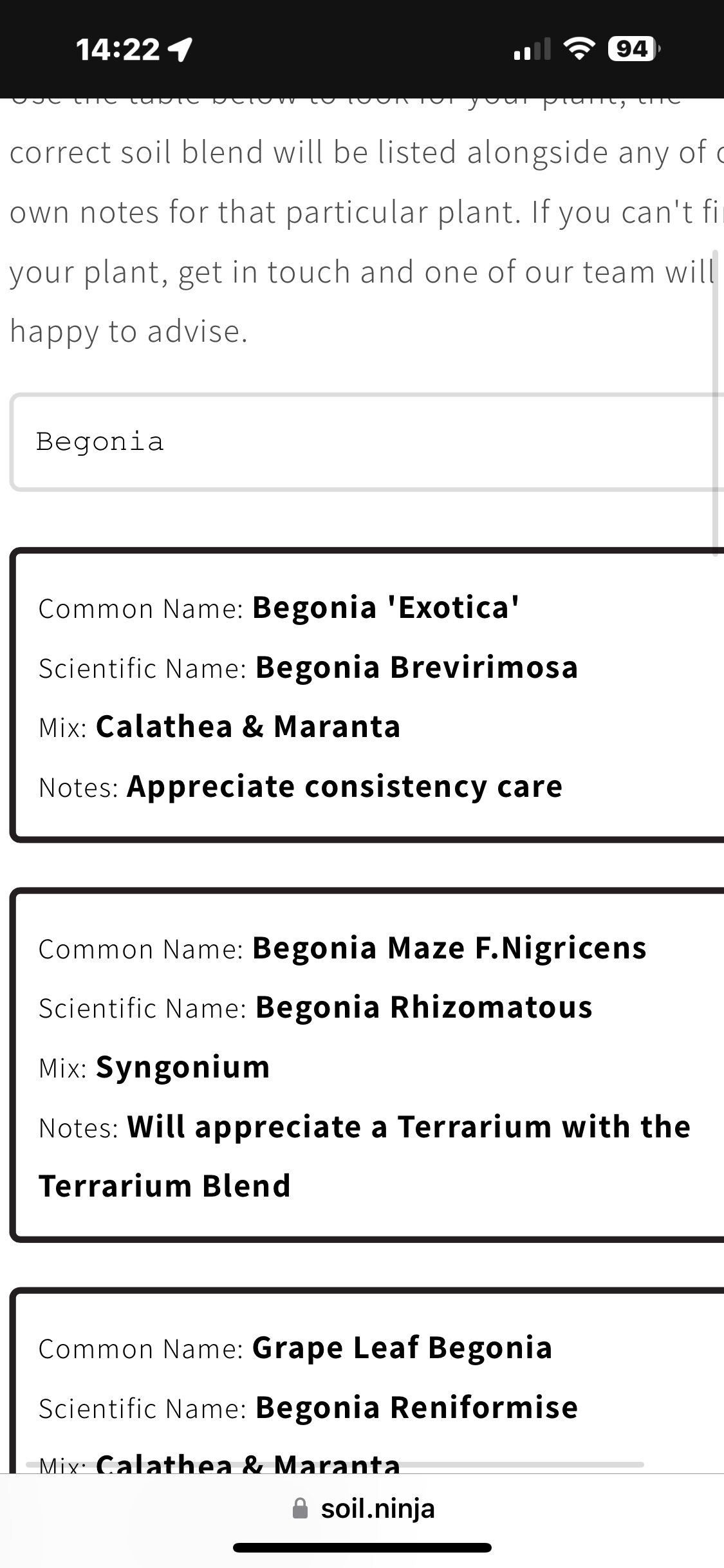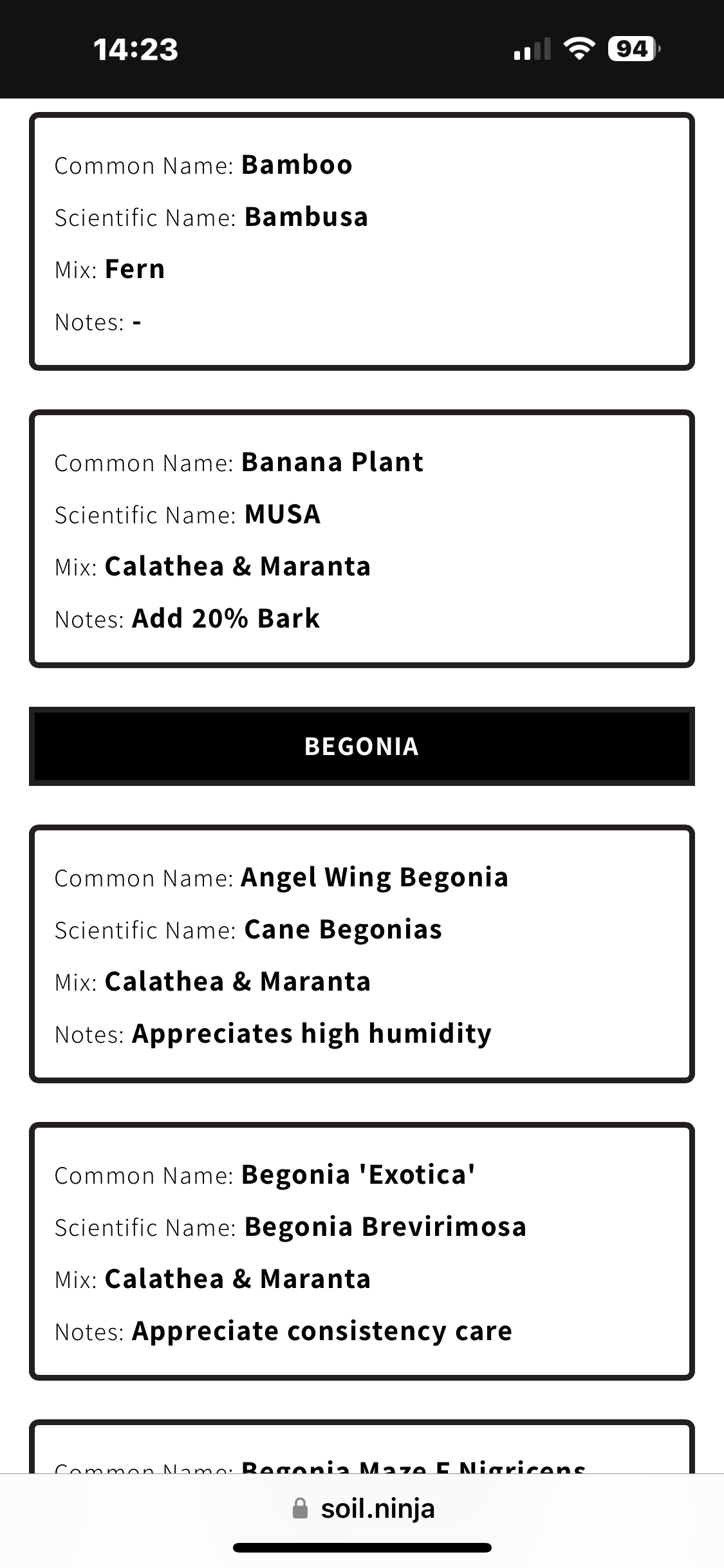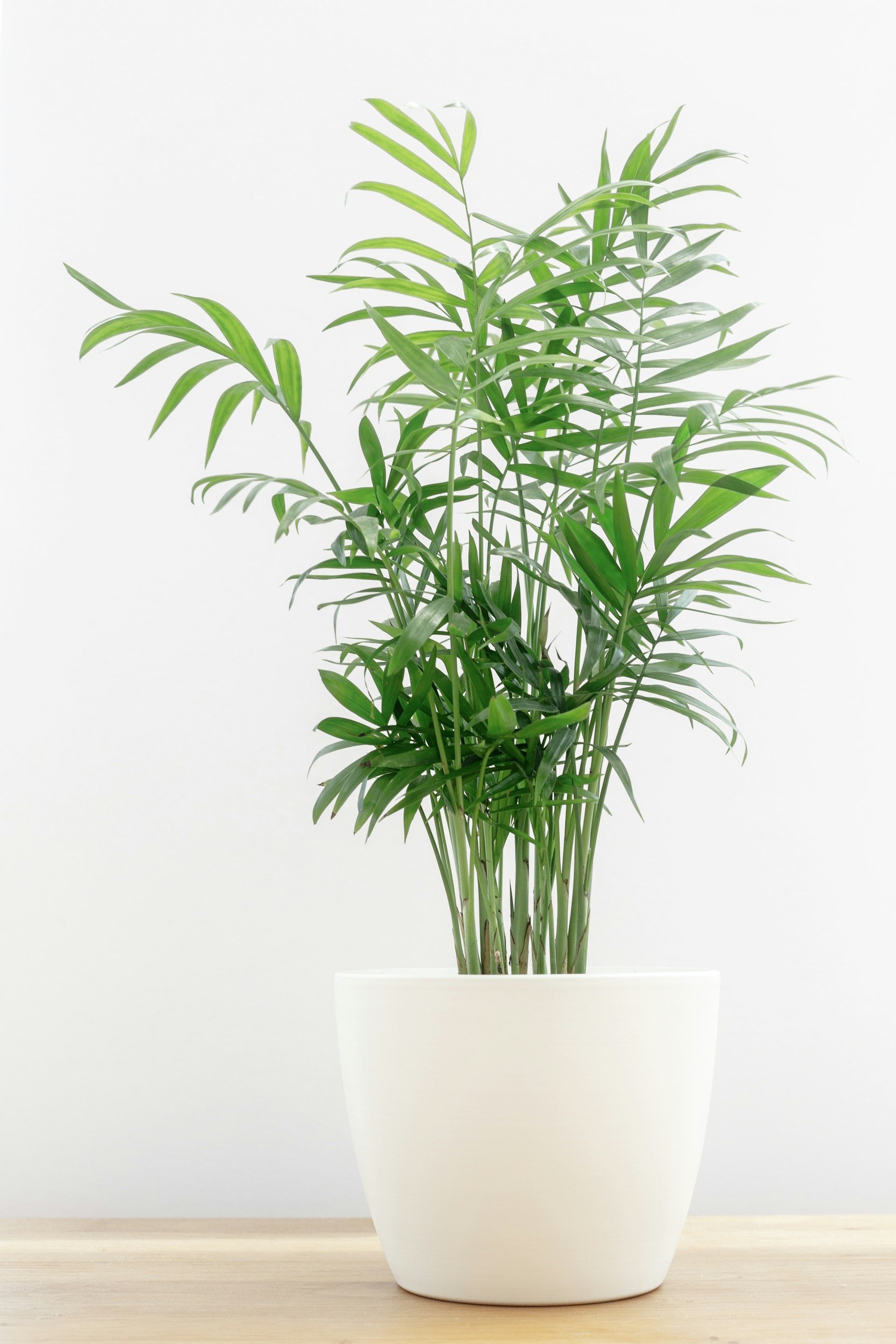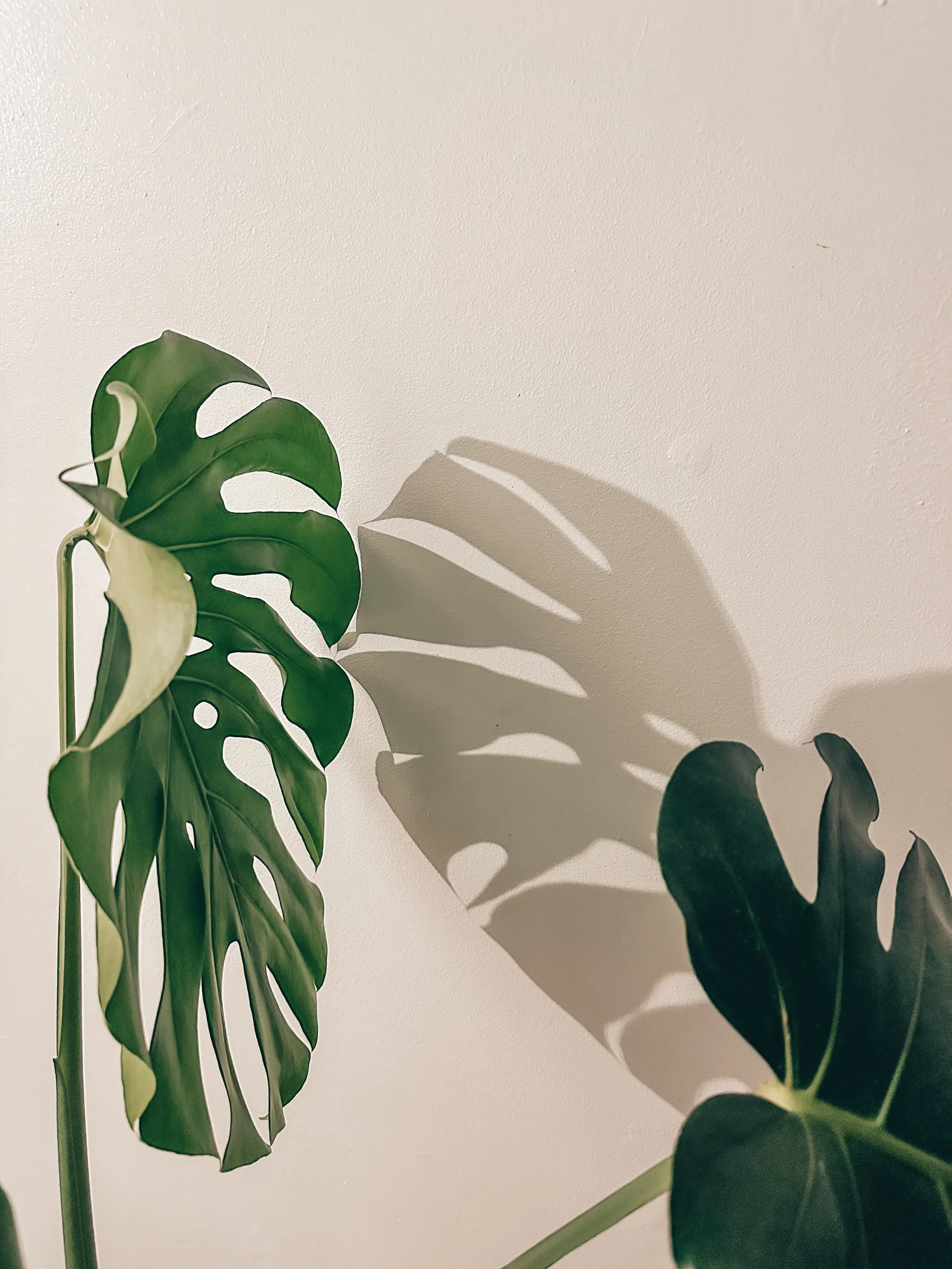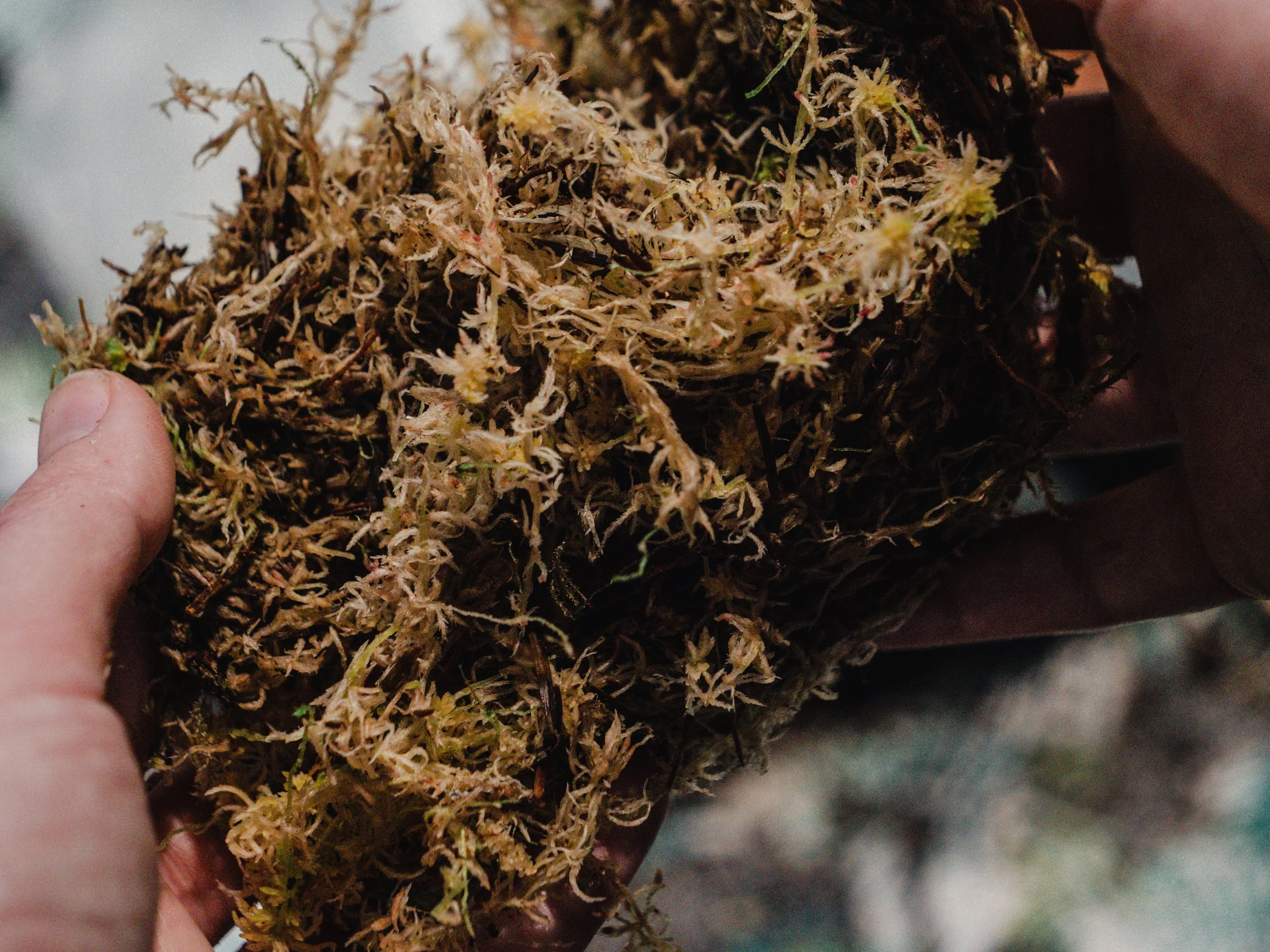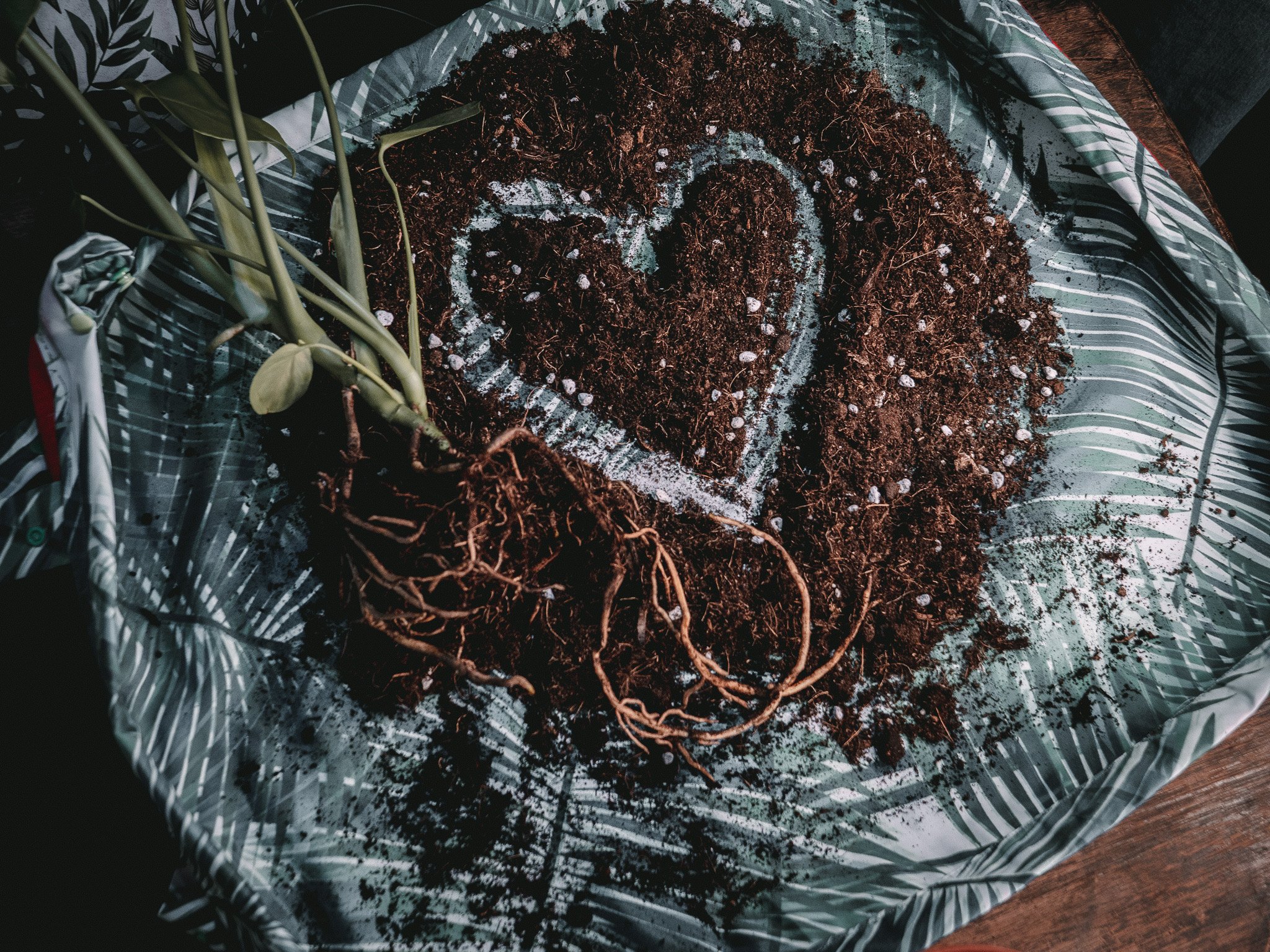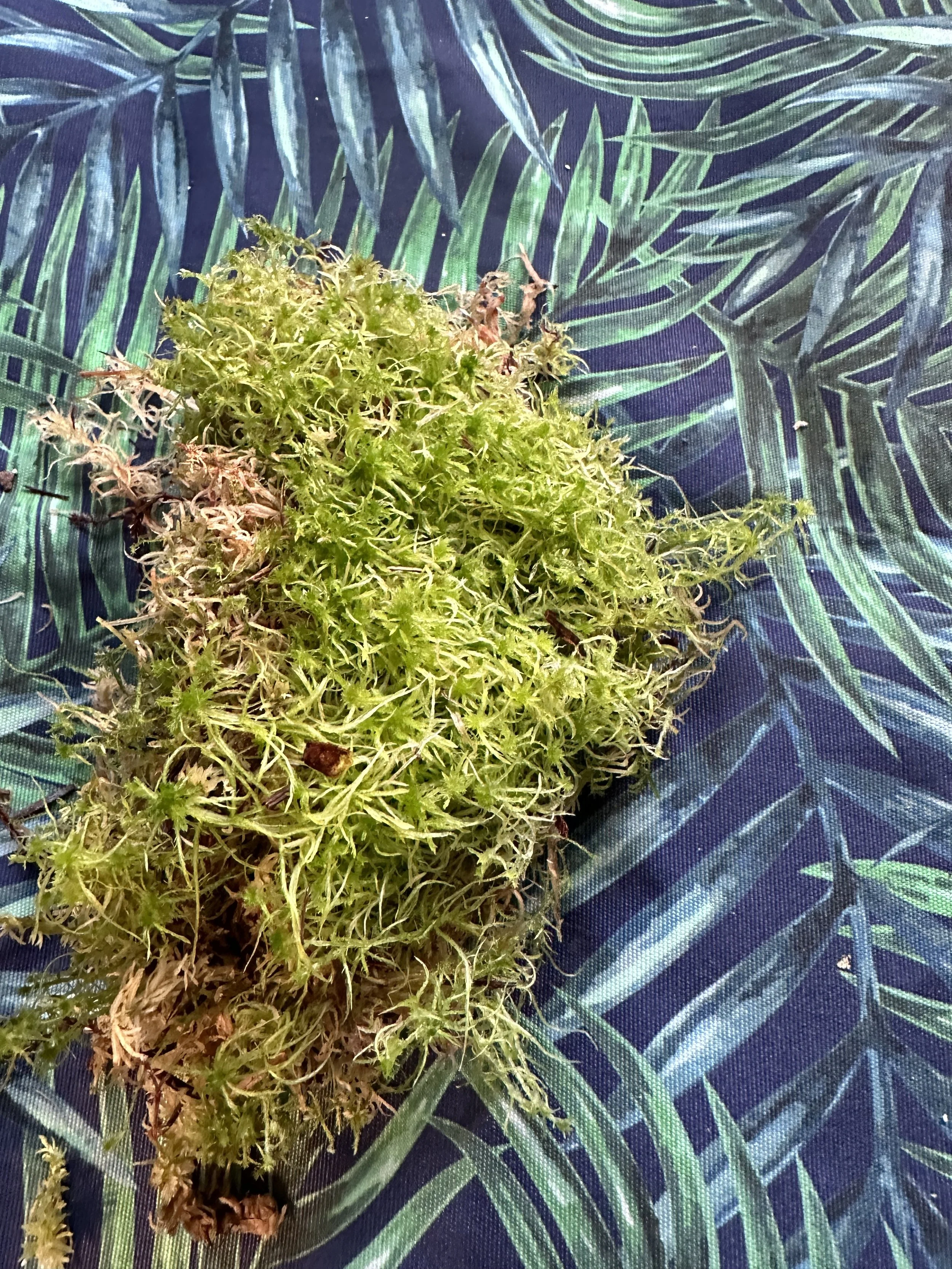Soil and Componenets
I often hear people discussing their preferred methods of plant propagation and growing techniques. For me, I discovered the Soil Ninja soil method about three years ago. Previously, I had been using Westland House plant Mix, not realising that it was not the best option for my plants. The Westland mix contained mostly peat compost, which caused the soil to retain too much water or not enough. Also when I started collecting for real alot of House plant composts were only just changing the peat free. Because Peat or having just coco coir lead me to frequently over watering my house plants or not watering them sooner at they would dry out to quickly. Which was not making it easy to look after plants like Maranta, Alocasia, and Begonia that can't tolerate drying out. That's when I discovered Soil Ninja. They taught me to research where the plant is from and not rely solely on the tag's instructions, which they often say same, thing: bright spot, water once a week.
I started looking at various plant types and realised Soil Ninja didn't have a mix for each plant, but they did have a plant index which was helpful.
The list of plants on the index is impressive and helps to understand the best soil mix for your house plant Genus or species. Over the years, they have put in a lot of work to adapt to the soil quality they naturally grows in. I would highly recomend checking this plant index out to help you understand the soil that you plant needs.
By mimicking the environment of our house plants, we can help them adjust to growing in an environment that is vastly different from their natural habitat. However, it's important to note that my advice and understanding come from a UK grower's perspective in the Fens, a very humid part of the UK that can get cold during the winter. If you live anywhere else, please keep in mind that my advice may not apply to your specific location. I would like you to consider whilst reading this is your house might be old like my house was in Cambridge and it was either so cold or super hot. Everyone has there own plant environment and this is something for you to consider before continue to read this blog. I have used my own UK grower experience as well as knowledge and research from others.
Whilst researching for this blog, I decided to introduce myself to the environment in my back garden and the environment of different soils around me exploring what I observe from that sample and checking on the PH of the soil also. The way I did this was using my potting mat I took a few different Samples. First Sample I took was the soil in my back garden. Firstly I took note that it was very grainy and fully of stones and rubble. It appeared to have the texture of clay when wet. I tested the PH of this soil concluding that it was very Alkaline and would struggle to retain moisture. I noticed this over the next few days with the rain and even a few days of rain it didn’t look like the soil had be wet previously.
A cactus enjoys one big watering every now and then and no water during the winter, as it gets too cold for the cactus to actively grow unless you can replicate its ideal environment. Many cacti come from dry environments with soil that is often made of sand, silt, and porous stones like pumice. They tend to prefer soil that is neutral to slightly alkaline in pH. I decided to measure a cactus mix myself to add to this understanding. I discovered the Soil Ninja Cactus mix to be more alkaline, with a pH of 9.0. This is likely due to sodium content, which makes the soil dry out easily.
The recommendation for your plant mix will be very different depending on the natural environment your plant would normally grow in. Lets Explore a few examples of plants and there environment.
Alocasia
Plants grow predominantly in primary and secondary forests, early regrowth areas, open swamps, on the forest floor, in leaf litter, and sometimes in humus deposits on rocks. They are usually found in lowlands, in ever-wet conditions, and in deep shade. Focus in on the Alocasia Zebrina which grows naturally in the Philippines which has generally two seasons wet or dry, soil would be peaty and wet.* Volcanic Ash may likely be present, meaning the soil would very fertile, retaining a large amount of moisture. Philippines is a place of lots of little islands this will make for a very humid environment with low land rain forests and
Chamaedorea elegans Aka Parlour Palm
Plants like the Chamaedorea elegans, also known as the Parlour Palm, grow natively in Southern Mexico and Guatemala. These regions have high humidity, thin soils, and volcanic activity, resulting in very fertile and stony soils with limestone. This is due to the prevalence of steep slopes and deforestation. By exploring this information, you can understand the type of soil suitable for this plant. Volcanic soils can range from very acidic to neutral, and they are likely to hold a lot of water while still allowing air to flow to the roots. some of these plants may be closer to the ocean with water on both sides and sandy beaches.
Monstera Deliciosa
In its native habitat, it can reach 20 m as it climbs up trees, by means of aerial roots, in search of light. The aerial roots hang down like curtains from thick, fibrous stems. * Because these plants are set to climb this would mean that they like the humdity but don’t mind drying out. I’ve explored and research the soil they like best would be well draining as they climb. A lot of places they naturally grow well can Be sandy soil and are consider if in the shade can deal with lack of water every so often.
Here in these photos I was Exploring different soil types in the hopes to help you understand the research I have done personally in writing this blog. I explored Cacti Soil, Garden Soil. Standard Compost, Alocasia mix that I had made they need to be mixed with water so i could measure the ph of the soil and Show you the composition for the soil. (Photos include the Philodendron Potting Mat).
So lets Talk Soil! Top Five Components.
Vermiculite
Wet Vermiculite
I love using Vermiculite its a great product that holds a lot of moisture great for getting seedlings growing. Soil Ninja says ‘The small, brightly coloured component will expand with moisture in what can only be described as an 'accordion' fashion. It's small movements in a soil blend help with aeration but above all else, this fabulous material maintains moisture for extended periods of time! Slowly releasing water and nutrients back into the soil - even days after it was watered.’* its another one of those versatile components I honestly love adding to my Alocasia mix if I’m creating my own of course. I also find its great for growing corms in to and I often use it as a lower layer in my prop box as it holds so much water. I found it to be useful in many parts of being a house plant lover.
Fine Bark
Fine Bark is a great addition to a aroid mix not only does is smell line a pine forest it also its a great for orchids to. Holds moisture and releases Nutrients into the substrate mixes. ‘Bark is a brilliant medium for inoculated mycorrhiza! The slightly acidity balance is the perfect colonisation ground for them to aid your plants with up-taking macro nutrients and out competing bad fungi!’*
Activated Charcoal
Has the ability to clear out impurities and bad bacteria, to hold moisture allowing air flow in the Substrate mix. Keeps the roots free of rot. Can balance out the ph in a largely alkaline soil. Great for a drainage layer and it provides air to move around the roots.
Zeolite
I love this component so much and its one that totally blows my mind.. it changes colour when wet. (picture left) Its porous component with properties to transform the soil mix to prevent rotten roots. Making sure that the roots are gaining the water and nutrients the plant needs without overloading the plant. This component slowly releases the nutrients to the plants roots over time keeping the Ph balanced.
Cactus soil with grit, pumice, clay, shells, sand, coco coir and activated Charcoal.
Sphagnum Moss
Fresh is best !
I want start by saying that without a doubt I prefer fresh Sphagnum Moss, this is because when I use fresh moss I’ve found its less likely to Deteriorate, go mouldy and is Resilient if it starts to dry out. It bonces back with a quick water. This substrate is great for propagation of your baby plants or in you moss poles. Orchids, Anthuriums and Alocasia love it as part of there substrate. If I am mixing it in soil sometimes prefer rehydrated works better for those Carnivorous plants. Sphagnum Moss is said to hold 20 times its weight in water. The Fresh moss is full of great microscopic plants and animals. ‘Sphagnum mosses grow from spores which are produced in fruiting bodies called capsules. When the spores are ripe, pressure builds up in the capsule until its lid is blown off, sending the spores shooting into the air.’* This fantastic substrate is great for walls in you terrariums for increasing Humidity and helping your plants to get water from the moss pole as it climbs. In this component its full of friendly microorganisms. That can benfit the plant in many different ways.
When repotting you plants heres a couple of things to consider:
What type of house plant is it look at how it grows Naturally does it look like it climbs or trails?
Before bringing home take a picture on the google app to see where the plant originally comes from.
Do not use soil from outside with your house plants as this can be very Alkaline and the Compost mixes can be to rich and hold to much moisture.
When repotting check for plugs around the base of the plant as these can often restrict growth. and store up to much water causing root rot.
Many people, including myself, often make the mistake of using pots that are too big or repotting plants too soon. Most houseplants like to be snug in their pots. Just because you want your plant to grow bigger doesn’t mean a larger pot will help.
Don’t just take my word for it or any influencers its so worth doing your own research. As well as learning from other peoples experiences.
This was the early days of Soil Ninja !! now they have these super awesome resealable bags that you can reuse and recycle. This photo was also taken before I created Jungle Floor Pottings Mats.
If you would like to know more about my recommendations on Soil Ninja check out my blog. You will Also find some if not all the Components mentioned in this blog on Soil Ninja’s Website link below. I included some of the places I gain research whether this was through citation or direct quotes and further reading is below.
Citations and Research resources:
Recommended Components: https://www.soil.ninja/collections/soil-components
Cited 22/4/24 https://www.sciencedirect.com/science/article/abs/pii/S014019632030224X , Soil attributes and the quality and yield of ‘Gigante’ cactus pear in agroecosystems of the semiarid region of Bahia, Matos, Laudiceio Viana, Donato, Sérgio Luiz Rodrigues, Kondo, Marcos Koiti, Lani, João Luiz , Aspiazú, Ignacio, 22 September 2020.
Cited 23.4.24 https://www.aroidpedia.com/alocasia, HABITAT: SUBSTRATE:,
Hernandez, Carolina G. , Cullinane, Michael and Borlaza, Gregorio C.. "Philippines". Encyclopedia Britannica, 1 Aug. 2024, https://www.britannica.com/place/Philippines. Accessed 1 August 2024.
Soil Ninja, 15th October Understanding Activated Charcoal, https://www.soil.ninja/blogs/dojo/activated-charcoal Cited 17/06/2024
Horst, Oscar H. , Stansifer, Charles L. , Anderson, Thomas P. and Griffith, William J.. "Guatemala". Encyclopedia Britannica, 31 Jul. 2024, https://www.britannica.com/place/Guatemala. Accessed 1 August 2024.
M. Nanzyo, S. Shoji, R. Dahlgren, Chapter 7 Physical Characteristics of Volcanic Ash Soils, Editor(s): Sadao Shoji, Masami Nanzyo, Randy Dahlgren, Developments in Soil Science, Elsevier, Volume 21, 1993, Pages 189-207
MONSTERA GROWING IN THE FLORIDA HOME LANDSCAPE, Jonathan H. Crane, January 7, 2020, https://edis.ifas.ufl.edu/publication/HS311, Cited 06/08/24
Quotes
* Soil.Ninja understanding Vermiculite, written 15th October 2021, Quoted 17/6/2024, https://www.soil.ninja/blogs/dojo/vermiculite
* Soil Ninja Understanding Bark, Written October 2021, Quoted 17/6/2024, https://www.soil.ninja/blogs/dojo/bark
*Irish Peatland Conservation Council, Sphagnum Moss , Action for Bogs and Wildlife in Ireland, Quoted 31/07/24, https://www.ipcc.ie/a-to-z-peatlands/sphagnum-moss-the-bog-builder/#:~:text=Sphagnum%20mosses%20can%20hold%20up,their%20own%20weight%20in%20water.
BRAHMS Online Copyright © 1985 - 2024 Department of Biology, University of Oxford Monstera deliciosa Liebm. (Araceae), Oxford University 100 plants, Quoted: 06/08/24


